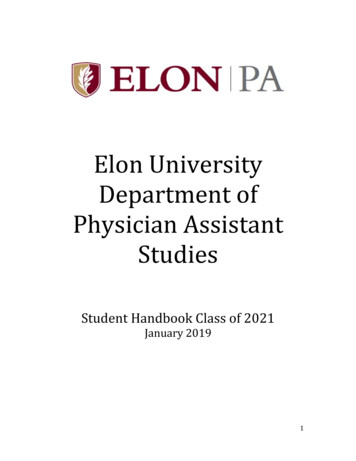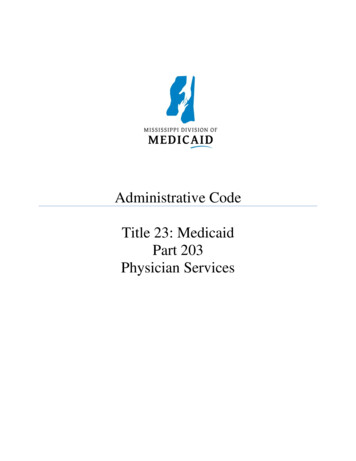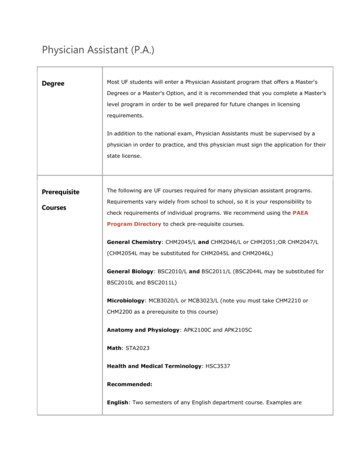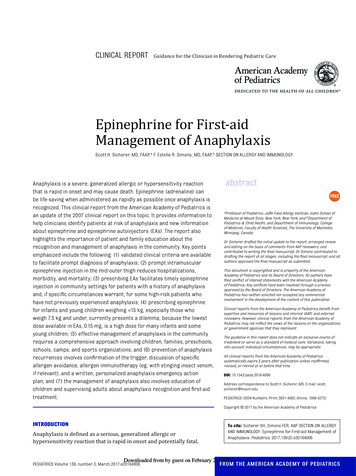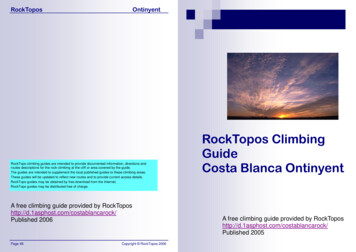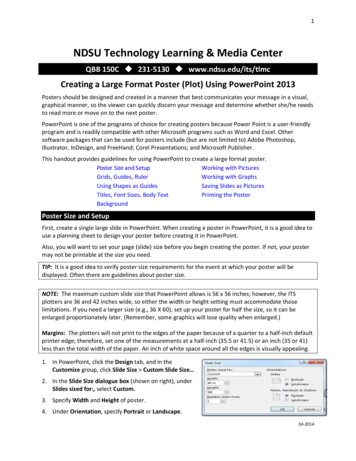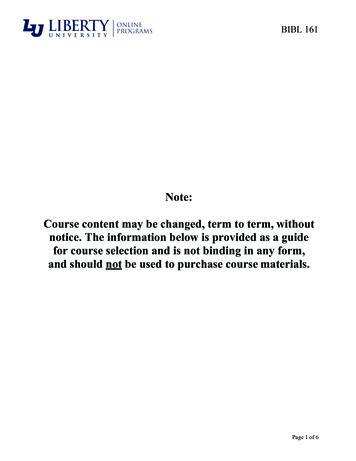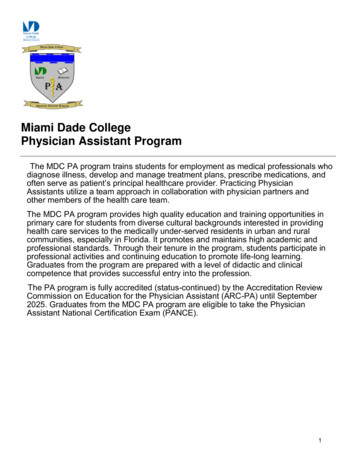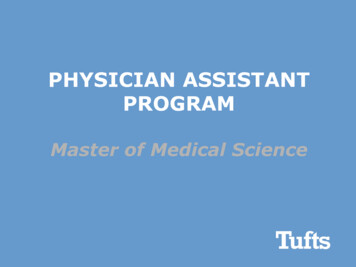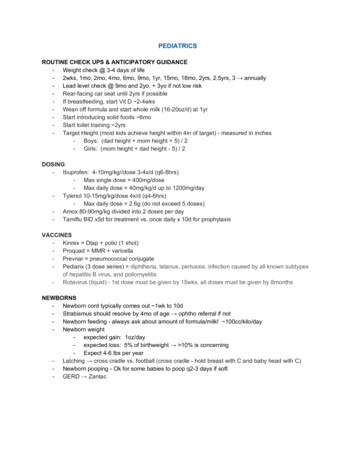
Transcription
PEDIATRICSROUTINE CHECK UPS & ANTICIPATORY GUIDANCE- Weight check @ 3-4 days of life- 2wks, 1mo, 2mo, 4mo, 6mo, 9mo, 1yr, 15mo, 18mo, 2yrs, 2.5yrs, 3 annually- Lead level check @ 9mo and 2yo, 3yo if not low risk- Rear-facing car seat until 2yrs if possible- If breastfeeding, start Vit D 2-4wks- Wean off formula and start whole milk (16-20oz/d) at 1yr- Start introducing solid foods 6mo- Start toilet training 2yrs- Target Height (most kids achieve height within 4in of target) - measured in inches- Boys: (dad height mom height 5) / 2- Girls: (mom height dad height - 5) / 2DOSING- Ibuprofen: 4-10mg/kg//dose 3-4x/d (q6-8hrs)- Max single dose 400mg/dose- Max daily dose 40mg/kg/d up to 1200mg/day- Tylenol 10-15mg/kg/dose 4x/d (q4-6hrs)- Max daily dose 2.6g (do not exceed 5 doses)- Amox 80-90mg/kg divided into 2 doses per day- Tamiflu BID x5d for treatment vs. once daily x 10d for prophylaxisVACCINES- Kinrex Dtap polio (1 shot)- Proquad MMR varicella- Prevnar pneumococcal conjugate- Pediarix (3 dose series) diphtheria, tetanus, pertussis, infection caused by all known subtypesof hepatitis B virus, and poliomyelitis- Rotavirus (liquid) - 1st dose must be given by 15wks, all doses must be given by 8monthsNEWBORNS- Newborn cord typically comes out 1wk to 10d- Strabismus should resolve by 4mo of age ophtho referral if not- Newborn feeding - always ask about amount of formula/milk! 100cc/kilo/day- Newborn weight- expected gain: 1oz/day- expected loss: 5% of birthweight 10% is concerning- Expect 4-6 lbs per year- Latching cross cradle vs. football (cross cradle - hold breast with C and baby head with C)- Newborn pooping - Ok for some babies to poop q2-3 days if soft- GERD Zantac
SICK VISIT- Strep pharyngitis - always tx for 10 days - proven duration to prevent rheumatic fever!- PCN is first line, but liquid PCN tastes gross Amoxicillin x10d (rash w/ mono!)- PCN VK 500mg BID x10d (if pt can swallow pills)- New toothbrush in 24hrs after starting abx- Can return to school after being on abx for 24hrs (no longer contagious)- Many kids have stomach aches with strep- Fusobacterium necrophorum pharyngitis (high CRP & WBC) PCN clindamycin- PNA typically treat with amox and azithro- Atypicals mycoplasma, chlamydia, viral- Sx: insidious onset, dry cough, N/V/D, HA, myalgias, sore throat- tx : macrolides (azithro) or levofloxacin- Otitis Media Amox 90mg/kg/day divided into 2 doses x 10 days for younger kids- Agents: S . Pneumonia, H. influenza, M. catarrhalis, viral- 1st line Amoxicillin (500-875mg BID x5-10d depending on severity)- 2nd line (if amox fails) Augmentin x10d- PCN allergy ceftriaxone (can give IM but kids don’t like shots)- Beta-lactam allergy macrolide (azithromycin, erythro)- Serous otitis media OME fluid behind TM without presence of infx- Usually result of previous AOM, barotrauma, chronic eustachian tube dysfxn- Common to have pharyngitis with OM- Recurrent OM 3 episodes of AOM in 6mo, or 4 in 1yr- Perforated TM d/t infx amoxicillin PO Floxin otic drops- Mastoiditis suppurative infx of mastoid air cells- Otitis Externa- Etiology: **bacterial (pseudo, strep, staph), fungal, eczema- Sx: tragal pain, hearing loss, otorrhea, fullness, itching, recent exposure to water- Tx: neo/poly/HC if TM intact, FQ (cipro/ofloxacin)- FQ will cover pseudomonas- Malignant OE osteomyelitis of temporal bone as a result of chronic infection in DM, notcancerous! emergent ENT referral- Conjunctivitis- Bacterial typically unilateral, viral typically affects 2nd eye 24-48hrs later, allergic itchy- If infant, think chlamydia or gonorrhea- Recommended standard prophylaxis given immediately after birth includeserythromycin ointment, topical tetracycline, silver nitrate, or povidone-iodine- IM ceftriaxone needed once infection has occurred- 50% of peds conjunctivitis is bacterial, so tx w/ abx even if suspect viral- *Ocuflox drops 1 drop 4xd until clear for 2 days (use for one day past when it looksbetter)- Polytrim (polymyxin B sulfate and trimethoprim ophthalmic solution, USP) x5d- Bronchiolitis inflammation of bronchioles causing wheezing & airway obstruction- **RSV, rhinovirus, adenovirus, influenza, parainfluenza- CXR hyperinflation, interstitial pneumonitis, infiltrates- prednisone 20mg tablet TID x5d- albuterol sulfate HFA 90 mcg/actuation aerosol inhaler 2 puffs q4hrs prn- Croup cool mist humidifier, steroids, epi at hospital if severe- **parainfluenza virus, RSV
--Stridor, hoarseness, barking cough, lowgrade fever, rales, ronchi, wheezing (worse inpm)Allergic Rhinitis- Samter’s triad syndrome of aspirin sensitivity, nasal polyposis, and asthma often seenwith allergic rhinitis, frequently leading to severe pansinusitisURI dexamethasone*, neb txPertussis macrolide is DOC (azithro), bacrim as alternativeOrbital Cellulitis typically d/t rhinosinusitis (m/c ethmoid sinusitis) vanc zosyn/unasyn/ceftriaxoneCOMMON COMPLAINTS- Bedwetting 11pm wake up, bedwetting alarm (pottypager), DDAVP- Risk factors for oral candidiasis ICS, abx use, AIDS KOH prep- Tx: oral nystatin rinses (or swabs if infant) or systemic fluconazole if severe- ASTHMA - Spo2 may go decrease slightly after neb tx okay! d/t V/Q mismatchTORCH INFX Toxoplasmosis Other - Syphilis Rubella CMV Herpes - HSV 1 (predominantly oral-labial) & HSV 2 (predominantly genital) If mom has active vaginal infx, child has 50% of transmission Does NOT increase risk of congenital malformations complication - vesicles, resp distress, seizure, meningoencephalitis, impaired neuro devel HSV 1 more common in infancy widespread, severe herpetic gingivostomatitis withoral erosions eczema herpeticum occurs when infant w/ preexisting eczema develops adisseminated HSV infx; can be life-threatening, requires immediate IV acyclovir Dx tzank smear (“multinucleated giant cells”), viral cx, antibody stainingACUTE RHEUMATIC FEVER Sequela that happens within weeks ( 2-4wks) after GAS tonsillopharyngitis Jones criteria 2 major, or 2 minor 1 major, manifestations w/ evidence of preceding GAS infx 5 major manifestations: carditis & valvulitis, arthritis (usually migratory polyarthritis of largejoints), CNS involvement ( chorea ), subcutaneous nodules, erythema marginatum 4 minor manifestations: arthralgia, fever, elevated ESR/CRP, prolonged PR interval Acute febrile illness (m/c) vs. neurologic illness (less common, slower onset) Carditis: pancarditis that can involve the pericardium, epicardium, myocardium, and endocardium;the predominant manifestation of carditis is involvement of the endocardium presenting as avalvulitis , especially of the mitral and aortic valves; usually presents within 3wks of GASinfection. The presence of valvulitis is established by auscultatory findings together withechocardiographic evidence of mitral or aortic regurgitation Late sequela RHD and Jaccoud arthropathy RHD usually occurs 10 to 20 years after the original illness, although it may presentearlier after a severe or recurrent episode of ARF. It is the most common cause ofacquired valvular disease in the world; MV AV, mitral regurg ism/c finding; may progressto mitral stenosis
KAWASAKI DZ Generalized vasculitic dz of medium-sized arteries, unknown etiology but thought to be infectious m/c in Asians, 5yo Criteria Fever for 5 days with ⅘ of the following: : Edema & erythema of hands & feet w/ periungual desquamation Polymorphous exanthem (widespread rash, most pronounced in perineum) Conjunctivitis (limbic sparing) Oropharyngeal mucosal changes (throat erythema, strawberry tongue, red cracked lips) Cervical LAD 1.5cm (usually unilateral, nontender) Lab findings: increased ESR/CRP, thrombocytosis, normocytic anemia May also see sterile pyruria, inc. ALT/AST, RUQ pain (hydrops of GB) Cardiac findings: Coronary artery aneurysm** (most serious complication) Coronary arteritis (increased size or lack of tapering) Decreased LV contractility Pericardial effusion Mild valvular regurgitation Treatment High dose IVIG and aspirin Echocardiogram surveillance Without tx in first 10d 25% develop coronary artery aneurysm With trx 5% develop coronary artery dilation, 1% aneurysmHYPERTROPHIC CARDIOMYOPATHY A genetic cardiomyopathy caused by mutations of the cardiac sarcomere characterized by left ventricular hypertrophy of various morphologies, with a wide array of clinicalmanifestations and hemodynamic abnormalities Autosomal dominant inheritance evaluate 1st degree relatives of affected individual Possible abnormalities: LV outflow obstruction, diastolic dysfunction, MR, MI LVOT murmur harsh crescendo-decrescendo systolic murmur that begins slightly afterS1 and is heard best at the apex and lower left sternal border MR murmur mid-late systolic murmur at the apex Sx related to HCM can be categorized as those related to HF, chest pain, or arrhythmias. fatigue, dyspnea, chest pain, palpitations, syncope/presyncope Patients with HCM have an increased incidence of both supraventricular and ventriculararrhythmias and are at an increased risk for sudden cardiac death (SCD).PEDIATRIC CANCERS Hodgkin’s lymphoma - m/c cancer among 15-19yo, Reed Sternberg cells ALL - 90% survival rate Lymphoblasts no auer rods, absent granules, smooth membrane, oval nuclei, highnuclei:cytoplasm ratio, deep blue/purple cytoplasm AML - 65% survival rate Myeloblasts auer rods, granules, irregular membrane, oval nucleus, lownuclei:cytoplasm ratio, gray/blue cytoplasm
PUBERTYThe median length of time between the onset of puberty (breast Tanner stage 2) and menarcheis 2.6 years, and the 95th percentile is 4.5 years.Stages in breast development in girls.Stage 1: Prepubertal, with no palpable breast tissue.Stage 2: Development of a breast bud, with elevation ofthe papilla and enlargement of the areolar diameter.Stage 3: Enlargement of the breast, without separation ofareolar contour from the breast.Stage 4: The areola and papilla project above the breast,forming a secondary mound.Stage 5: Recession of the areola to match the contour ofthe breast; the papilla projects beyond the countour of theareola and breast.
Stages of development in pubic hair in girls.Stage 1: Prepubertal with no pubic hair.Stage 2: Sparse, straight hair along the lateral vulva.Stage 3: Hair is darker, coarser, and curlier, extending overthe mid-pubis.Stage 4: Hair is adult-like in appearance, but does notextend to the thighs.Stage 5: Hair is adult in appearance, extending from thighto thigh.Stages of pubic hair development in boys.Stage 1: Prepubertal, with no pubic hair.Stage 2: Sparse, straight pubic hair along the base of thepenis.Stage 3: Hair is darker, coarser, and curlier, extendingover the mid-pubis.Stage 4: Hair is adult-like in appearance, but does notextend to thighs.Stage 5: Hair is adult in appearance, extending from thighto thigh.
PEDS DERMATOLOGYACNE VULGARIS--etiology: inflammation of pilosebaceous units, increased sebum production, follicularobstruction d/t hyperkeratinization, P. Acnes bacteria--causes: inflammatory response, stress, lithium, steroids, progestins, phenytoin--Papules, pustules, cysts, comedones (sebaceous follicles plugged with keratin & sebum)--Open comedone blackheads; Closed comedones whitehead--Persistent acne & hirsutism red flag for hyperandrogenism (PCOS, tumors)Treatment--Retinoid: Tretinoin , adapalene, tazarotene, isotrentinoin--Benzoyl Peroxide , salicylic acid--Spironolactone (aldosterone antagonist)--Topical abx (erythro or clinda) vs. Oral abx (minocycline, doxy , erythro)ECZEMA (DERMATITIS )ATOPIC DERMATITIS : “ the itch that rashes”--superficial inflammatory response of epidermis, T-cell mediated immune activation & IgE production--altered immune rxn in genetically susceptible populations when exposed to triggers--triggers: heat, perspiration, allergens, contact irritants (wool, nickel, foods)-- allergic triad : eczema, allergic rhinitis, asthma--tiny pruritic erythematous edematous ill-defined blisters dries/crusts over & scales--m/c in extensors and face in infants (flexor surfaces i.e. antecubital folds in adults)--emollient ointment (glycerol, petroleum jelly) ceramide moisturizers (Eucern)--topical corticosteroids (hydrocortisone, fluticasone, betamethasone) & antihistamines--topical immune modulators (calcineurin inhibitors i.e. Tacrolimus)CONTACT DERMATITIS : Type IV T-cell mediated rxn eczematous (irritant), vesicular (allergic) poison ivy Tecnu, calamine lotion, oatmeal baths, astringents (witch hazel) topical corticosteroids, oral antihistaminesASTEATOTIC DERMATITIS : very dry skin, scaling, cracking emollients, topicalsteroids, antihistaminesECZEMA HERPETICUM : fever & clusters of itchy blisters or umbilicated vesicles( punched out erosions ) oral antivirals ; emergency in kids! disseminated viral infection (HSV), generally occurs at sites of skin damage (eczema)DYSHIDRTOTIC DERMATITIS : pruritic “tapioca pudding” tense vesicles on palms, soles,fingers, webspaces triggers are sweating, stress, warm weather, metals tx w/ topical steroid ointment, cold compresses, tar soaksNUMMULAR DERMATITIS: oval weeping patches steroids, emollientsTINEADermatophyte Fungus Tinea capitis, tinea faciei, tinea barbae, tinea corporis, tineacruris, tinea manuum, tinea pedis, tinea unguium--Well-demarcated scaling plaque, KOH 10% hyphae--Terbinafine (Lamisil) x1-2wks (allymines), Ketoconazole x2wks, Griseofulvin PO fortinea capitis & unguium (avoid steroids and nystatin)Non-dermatophyte Fungus Tinea versicolor (M. furfur yeast)--Hypopigmented or erythematous macules with fine scale, no itch, predominantly on trunk--KOH spaghetti & meatball pattern w/ short hyphae & yeast--Fluconazole (Diflucan), Ketoconazole, Selenium sulfide
LICHEN PLANUS(papulosquamous)--idiopathic cell-mediated immune response--develop on flexor surfaces of extremities, mucousmembranes of skin, mouth, scalp, genitals, nails--Purple popular pruritic polygonal planar--Oral white lacy patches Wickam striae--Koebner phenomenon, fine scales--seen more in pts with HCV infxnTreatment: typically resolves in 8-12mo--1st line antihistamines, steroid ointment--2nd line systemic steroids, UVB therapyOral lichen planus increased risk for oral cancer (SCC)PITYRIASIS ROSEA(paopulasquamous)--idiopathic, likely post-viral, increased in spring/fall--Herald patch initial solitary salmon-colored macule on trunk general exanthem--salmon-colored oval/round papules with white circular scaling along cleavage lines--very pruritic, christmas tree pattern - confined to trunk & proximal extrem (face spared)--Self-limited, resolves in 6-12wks--Management: none needed, but for pruritus try topical steroids, PO antihistamines,moisturizers, oatmeal baths, /- UVB light if severeDRUG ERUPTIONS(hypersensitivity rxn)Type I IgE mediated , immediate (i.e. urticaria, angioedema)Type II Ab-mediated , cytotoxic (drugs in combo with cytotoxic antibodies)Type III immune ab-antigen complex (i.e. drug-mediated vasculitis & serum sickness)Type IV delayed cell-mediated (i.e. EM)Nonimmunologic cutaneous rxns d/t genetic incapability to detoxify certain drugs(anticonvulsants, sulfonamides)--most are self-limiting if offending drug d/c--may be accompanied by fever, abd or joint painURTICARIA(hypersensitivity rxn)--Type I / IgE-mediated--triggers: antigen from foods, meds, infxn, insect bites, drugs, environment--path: mast cells release histamine vasodilation of venules edema of dermis &subq tissue--blanchable, edematous pink papules, wheals, or plaques--Darier’s sign localized urticaria appearing where the skin is rubbed--angioedema painless, deeper form of urticaria affecting the lips, tongue, eyelids,hands, feet & genitals (anaphylaxis may occur)--tx: PO antihistamine*, H2 blockers, corticosteroids, eliminate precipitantsERYTHEMA MULTIFORME(hypersensitivity rxn)--acute self-limiting type VI rxn, usually evolve over 3-5d and persist 2wks--infxn: HSV**, mycoplasma (kids), S. pneumonia--meds: sulfa drugs, B-lactams, phenytoin, phenobarbital-- TARGET LESION ; dull “dusty violet” red, purpuric macule/vesicle or bullae in center,surrounded by pale edematous rim & peripheral red halo--often febrile--minor target lesions distributed acrally, no mucousal membrane lesions--major target lesions involved 1 mucous membranes (oral, genital, ocular mucosa)--Tx d/c drug, antihistamines, analgesics, skin care--- steroid/lidocaine/diphenhydramine mouthwashes for oral lesionsSJS & TEN(hypersensitivity rxn)--severe blistering mucocutaneous syn (eyes, mouth, genitals)--seen esp with sulfa & anticonvulsant drugs--infx: mycoplasma , HIV, HSV, malignancy , idiopathic
--widespread blisters begin on trunk & face blistering & sloughing off of skin & mucousmembranes, epidermal detachment--tx treat like severe burnsSJS if sloughing 10% BSA (self limited, usually resolves in 1mo)TEN if sloughing 30% (toxic epidermoid necrolysis)IMPETIGO(bacterial, infectious)--vesiculopustular skin infxn, highly contagious--RFs warm, humid conditions, poor personal hygieneNon-bullous* m/c S. aureus (2nd m/c GABHS), a/w regional lymphadenopathy--vesicles, pustules “honey-colored crusted” erosions w/ moist erythematous baseBullous S. aureus (not common, usually seen in newborn, young children)--vesicles form large bullae rupture thick “varnish-like crusts”Bactroban 2% ointment (Mupirocin) x10 days, BacitracinExtensive dz Keflex, Clinda, Dicloxacillin, AzithromycinWash area gently w/ soap & waterMOLLUSCUMCONTAGIOSUM(viral, infectious)--benign viral infxn (poxviridae family), highly contagious (skin to skin & fomites)-- dome-shaped flesh-colored/pearly-white, waxy papules w/ central umbilication--curd-like material expressed from center if squeezed--usually spontaneously resolved in 3-6mo; /- imiquimod or podophyllin, cryosurgLICE / PEDICULOSIS--itching, papular urticaria near lice bites, visualization of live lice, visualization of nits(pearls on hair shafts) w/ eye or wood’s lamp--Tx: Permethrin 1% (shampoo & lotion), Ivermectin (Lindane but it is neurotoxic)--Examine household & close contacts--wash bedding & clothing in hot water w/ detergent, dry in hot drier x20min--toys that can’t be washed should be placed in air-tight plastic bag x14daysSCABIES (mites)--Sarcoptes scabei mites (cannot survive off human body 4d)--female mites burrow into skin and lay eggs, feed, & defecate (scybala fecal particlesprecipitate HSN in skin)--intensely pruritic, increased at night--red papules & linear burrows common in intertriginous zones i.e. webspaces, scalp(usually spare neck * face)--symptoms last 4-6wks, usually clinical dx, but can do skin scrapings for mites or eggs--Tx: Permethrin (Elimite) , wash clothing/bedding with heat & no body contact for 72hrspermethrin 5% cream - applied to all areas of the body from the neck down and washedoff after eight to fourteen hours - 2 applications separated by 1 weekOr oral ivermec tin - given as a single 200 mcg/kg dose repeated after 1-2wksVERRUCAECUTANEOUS HPVWart flesh-colored hyperkeratotic papule w/ red-brown punctations (thrombosedcapillaries)Verruca vulgaris common wartVerruca plantaris plantar wartVerruca plana flat wart (flat, pink/tan/flesh colored papules)Condyloma accuminata genital warts (HPV 6 & 11) tiny painless papules that evolveinto soft, fleshy, cauliflower-like lesions, ranging from skin-color to pink-red, occuring inclusters in the genital regions & oropharynx; lesions may spontaneously resolve, remainunchanged, or grow if not treated
Dx mucosal HPV will whiten with acetic acid applicationTx most warts resolve spontaneously in 2yrs if immunocompetent pts--vulgaris & plantaris topic OTC salicylic acid & plasters, cryotherapy, electocautery,CO2, laser, intralesional bleomycin--acuminata chemical, salicylic acid, cryotherapy, laser, podophyllin--guardasil vaccine protects against 70% of HPV strainsBURNSParkland formula LR @ 4ml x kg x BSA burn (half over 1st 8hrs, rest over next 16hrs)18% BSA on head, 14% each extremity (otherwise same as adult rule of nine’s)EXANTHEMSROSEOLA(6TH’S DISEASE)-- HHV 6 & 7 , spread by respiratory droplets, 10d incubation period--high fever 3-5 days defervescence coincides with rash-- rose pink maculopapular blanchable rash (trunk/back face)-- **only childhood viral exanthem that starts on trunk & spreads to face--tx supportive, anti-inflammatoriesHAND-FOOT-MOUTH DZ--coxsackie A virus (enterovirus), spread feco-oral and oral-orally--mild fever, URI sx, decreased app starting 3-5 days post-exposure rash-- vesicular lesions on a reddened base in oral cavity (buccal mucosa, tongue) lesions on distal extremities 1-2d post initial sxMUMPS--paramyxovirus, spread by respiratory droplets, 12-14d incubation period--low-grade fever, myalgias, headache painful parotid gland swelling--supportive, anti-inflammatories, MMR (sx usually last 7-10d)--complications: orchitis, encephalitis, aseptic meningitis, deafness, pancreatitisRUBEOLA / MEASLES--paramyxovirus, spread by respiratory droplets, 10-12d incubation period--URI prodrome: high fever, cough, coryza, conjunctivitis, k oplik spots (precedes rash24-48hr)--maculopapular (mobiliform) brick-red rash on face beginning at hairline extremities-- rash lasts 7 days, fevers concurrent w/ rash--tx: supportive, anti-inflammatories, isolate for 1wk after rash onset--complications: OM* , pneumonia, diarrhea, encephalitisRUBELLA(German Measles)--Togavirus, spread by respiratory droplets, 2-3 week incubation period-- rash lasts 3 days--low fever, cough, anorexia, LAD rash (may see photosensitivity & joint pains)--pink, light-red spotted maculopapular rash on face extremities ( blueberry muffin )--tx supportive, anti-inflammatories (generally no complications)--teratogenic (esp 1st trimester), part of TORCH congenital syn sensorineural deafness, cataracts, TTP, mental retardation, heartERYTHEMA INFECTIOSUM(5TH’S DISEASE)--parvovirus B19, spread by respiratory droplets, 4-14 day incubation period--coryza, fever slapped cheek rash w/ circumoral pallor 2-4d lacy reticular rashon extremities (spares palms & soles) resolves in 2-3 wks--tx: supportive, anti-inflammatories--complications arthropathy (in older kids and adults), aplastic crisis w/ SSDRashes that affect palms &soles.Coxsackie (HFM), RMSF (esp wrist), syphilis (secondary), Janeway lesions, Kawasaki,measles, TSS, reactive arthritis, meningiococcemia
DDX FOR NEONATAL JAUNDICE Physiologic Jaundice : increased rate of bili production (shorter RBC lifespan-- faster hgbbreakdown) decreased rate of bili elimination (immature liver); on set usually after first 24hrs oflife, peaks on day 3-5 (resolves by 7-10d) Breastfeeding jaundice : dehydrational insufficient milk intake hypovolemia hyperbilirubinemia; onset is usually seen later in 1st week of life Breast milk jaundice: factors in breast milk causing increased intestinal absorption of bili block the proteins in the liver responsible for breaking down bilirubin; onset is usually in 2nd week ABO incompatibility: different blood type causes Mom’s abs to attack fetus blood, causinghemolysis of fetal RBCs and increased bili production; onset within first few days G6PD deficiency: lack of G6PD enzyme makes RBCs more vulnerable to oxidative stress &lysis; r equires trigger (like medication) to manifest Crigler-Najjar & Gilbert syn: inherited defects in gene for UGT1A1, which catalyzes theconjugation of bili with glucuronic acid decreases bili conjugation Hypothyroidism: decreased ability of body to metabolize/conjugate bili (see conjugatedhyperbilirubinemia) Biliary atresia or intestinal obstruction: blockage leads to inability to excrete conjugated bili(see conjugated hyperbilirubinemia) Congenital infx: inflammation of liver or deposition of parasites/spirochetes hepatitis decreased liver function Sepsis causes hemolysis (one theory suggests that increased oxidative stress due to sepsisdamages neonatal red blood cells that are susceptible to cell injury) Others: maternal diabetes, galactosemia
PEDIATRIC CANCERS Hodgkin’s lymphoma - m/c cancer among 15-19yo, Reed Sternberg cells ALL - 90% survival rate Lymphoblasts no auer rods, absent granules, smooth membrane, oval nuclei, high nuclei:cytoplasm
